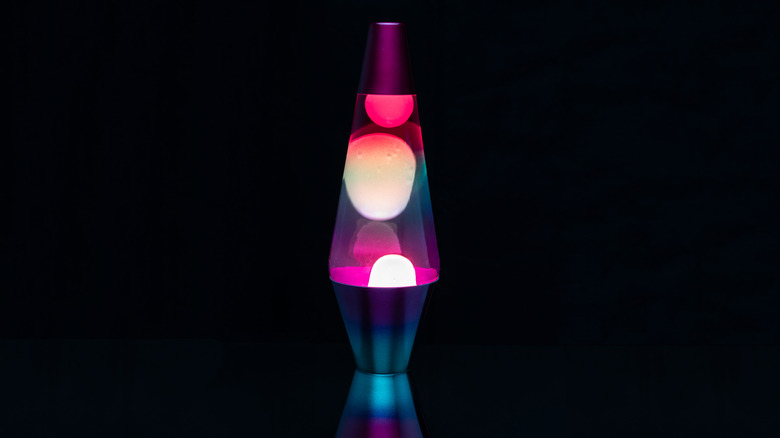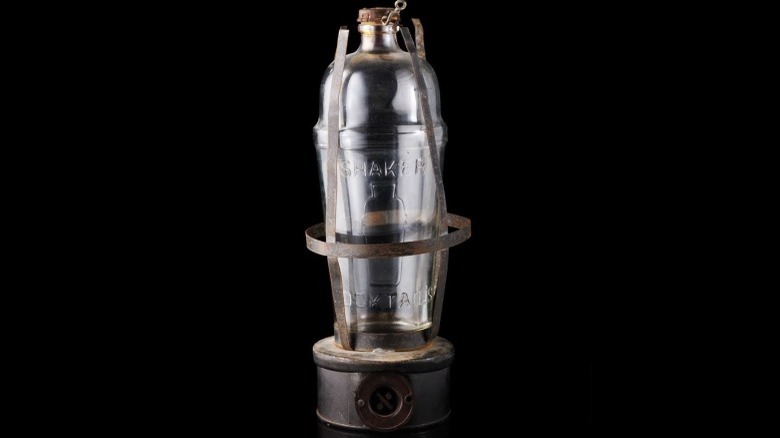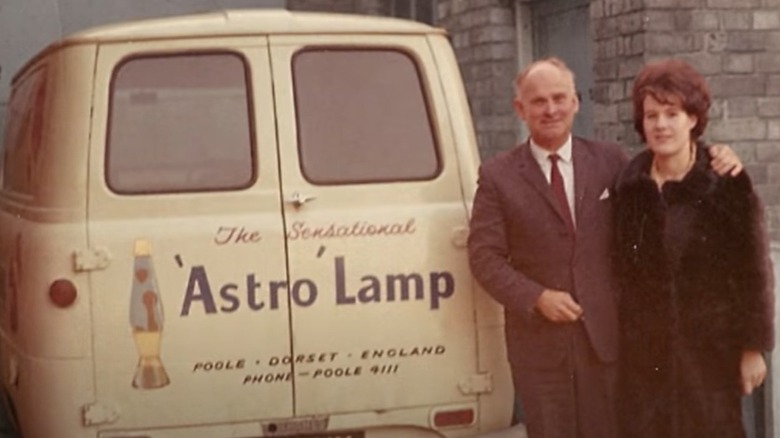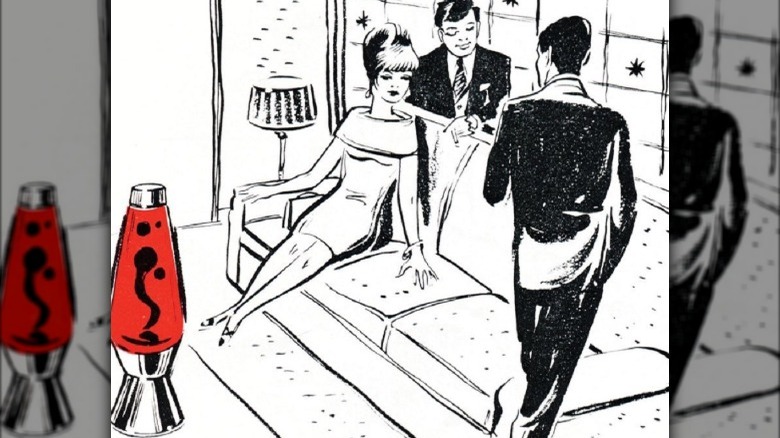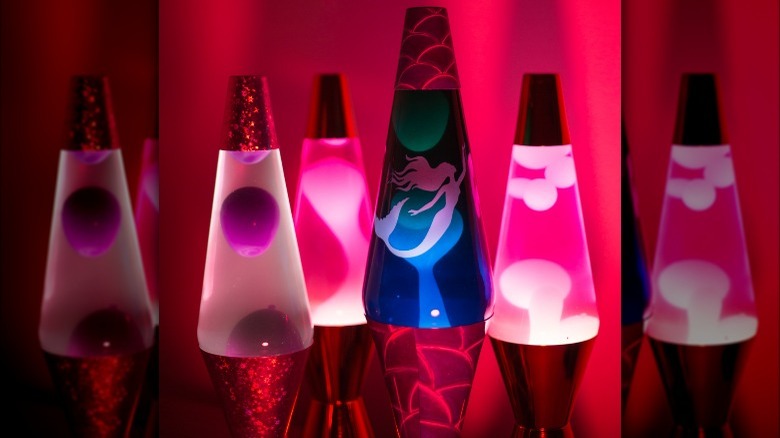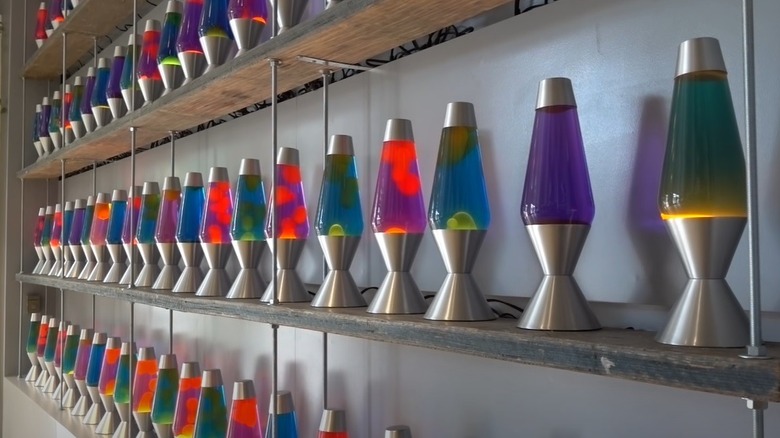What Happened To Lava Lamps?
When you see a lava lamp, the late '60s early '70s immediately comes to mind. The decorative light became synonymous with the hippie lifestyle and psychedelic counterculture during the flower power era, and as the lamp's inventor said, "If you buy my lamp, you won't need to buy drugs" (via The Inventors). Indeed, it's easy to get lost and relax while staring at the liquid blobs floating amid the soft glow of the light.
Lava lamps were such a success that by the '90s, the company that manufactured them had sold more than 7 million units all over the world. To this day, lava lamps remain popular lighting fixtures, especially for those who love the retro aesthetic. The company that started it all still manufactures lava lamps from the original factory, and they have added styles to their product line that include wall lamps, lava lamp projectors, candle-powered lava lamps, and even giant ones that stand 5 feet tall.
It was inspired by a cocktail shaker, old tins, and things
Edward Craven-Walker was a British pilot during World War II who was also an accountant and inventor. One night, he was having drinks at a pub in Dorset, England when he noticed a contraption made from what he described as a "cocktail shaker, old tins, and things," and it had a blob floating inside. It certainly was an odd thing, and it caught his interest enough that he just had to ask the bartender what it was. According to The Glow Company, the bartender explained that the object was an egg timer. The cocktail shaker was placed in boiling water together with the eggs. When the wax inside the shaker floats and turns into a blob, it signifies that the eggs are cooked.
Craven-Walker saw an opportunity in front of him and decided that he could turn the egg timer into a unique lamp. He looked for the genius who created the egg timer — an engineer named Donald Dunnet — but he had already passed away, per Imovate Design. Dunnet filed a patent for his invention in 1950, and it was granted in 1954. Craven-Walker spent the next 15 years improving Dunnet's invention and preparing for mass production.
The science behind the lava lamp
It took Edward Craven-Walker and his team a lot of experimenting to come up with the right compounds for the lamp. The floating blob is made of wax, but carbon tetrachloride is added to increase its density. When the lamp is turned on, the heat from the bulb at the bottom causes the wax to expand and be less dense, hence floating in liquid and rising to the surface. As it rises, however, the wax cools and sinks back to the bottom — and the cycle goes on and on as long as there's heat (via How Stuff Works). Craven-Walker's team eventually perfected the secret recipe, and all that was left to decide on was the container for the liquids.
Craven-Walker wanted to keep manufacturing costs down, and having custom glass containers blown wasn't an option for him at the time. He found the perfect glass that he wanted — the bottles for a popular beverage in England called Tree Top Orange Squash — which was shaped like a rocket. He sourced them in bulk from a producer, and he called the finished product Astro Lamp.
The lava lamp wasn't meant to be groovy
Edward Craven-Walker's Astro Lamp was launched in 1963. However, his intention wasn't for his unusual lamp to be a symbol for the psychedelic era. In fact, the hippie movement didn't start until 1965. Instead, Craven-Walker marketed his Astro Lamp for the "dignified" or "respectable" individual. The brochures depicted drawings of men and women wearing fancy clothing in various settings and introduced the lamp as "the exotic new conversation piece styled to fit any mood and decor in the home and all discerning establishments" (via The Walpole Barn). It wasn't an instant hit, and according to The Inventors, retailers thought the Astro Lamp was ugly.
In 1965, Craven-Walker attended a trade convention in Germany where he introduced the Astro Lamp. There, two Americans were fascinated with his product, and they bought the rights to manufacture the Astro Lamp in North America, as reported by Thought Co. They then renamed the lamps Lava Lite Lamp, and it flew off the shelves, as its introduction in the United States coincided with the start of the psychedelic counterculture in the mid-'60s. Although it wasn't what Craven-Walker intended, he seemed fine with his product being associated with the hippie culture. "It starts from nothing, grows possibly a little bit feminine, then a little bit masculine, then breaks up and has children. It's a sexy thing," he said in an interview (per The Independent).
The resurgence of the lava lamp
Millions of lava lamps had been sold by the late '60s, but it slowly dwindled and by the mid-'70s, the business was selling only a couple of hundred units each week. More than a decade later, however, sales started to ramp up once again, according to The Glow Company. There were those who wanted to purchase lava lamps for nostalgic reasons, but there were also others who scoured flea markets and bargain stores to get their hands on original lava lamps that were manufactured in the '60s to collect. In some cases, second-hand lava lamps sold more than brand new ones.
By the late '90s, lava lamps were popular once again, thanks in large part to the success of the first "Austin Powers" movie titled "Austin Powers: International Man of Mystery," which was released in 1997. The comedy film stars Mike Myers as Austin Powers — a British spy whose character parodied James Bond. The movie was set in the late 1960s, and of course, the lave lamp made an appearance. The popularity of the movie sparked renewed interest in the psychedelic style, and by 1998, manufacturers in the United States and England saw a drastic increase in sales that amounted to about 2 million units per year. Edward Craven-Walker died in 2000 at the age of 82 (via The New York Times), but his invention remains popular. "I think it will always be popular. It's like the cycle of life. It grows, breaks up, falls down, and then starts all over again," he said.
Lava lamps aid in internet encryption
For many, lava lamps are purely for decorative purposes. Sure, it's a lamp, but the light it emits isn't even that bright. For one company, however, lava lamps are not merely groovy items in their office. Cloudlfare, Inc. is a website security company based in San Francisco, and they have a wall of lava lamps — called the Entropy Wall — which aids in encrypting the internet, as reported by Nerdist. Internet encryption entails scrambling information and turning it into cipher text to make it secure for storage or transmission through the internet. In order for the encryption to be effective, however, the encryption keys must be random, and computers can't do that adequately. This is where the lava lamps are used.
Each lava lamp is unique, and the blob inside never takes the same shape twice. This is the type of consistent randomness needed for secure encryption. The Entropy Wall consists of about a hundred lava lamps, and cameras consistently take photos of the lamps. Each pixel corresponds to a value, so each image produced provides random text that the Cloudfare servers use to create strong and secure encryption keys. Who would have thought that an iconic psychedelic lamp would help in securing internet traffic? Certainly not Edward Craven-Walker.
